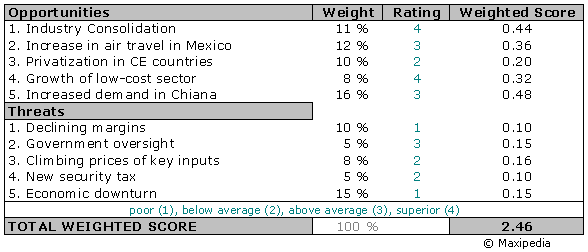EFE Matrix (External Factor Evaluation)
EFE Matrix (External Factor Evaluation)
External Factor Evaluation (EFE) matrix method is a strategic-management tool often used for assessment of current business conditions. The EFE matrix is a good tool to visualize and prioritize the opportunities and threats that a business is facing.
The EFE matrix is very similar to the IFE matrix. The major difference between the EFE matrix and the IFE matrix is the type of factors that are included in the model. While the IFE matrix deals with internal factors, the EFE matrix is concerned solely with external factors.
External factors assessed in the EFE matrix are the ones that are subjected to the will of social, economic, political, legal, and other external forces.
How do I create the EFE matrix?
Developing an EFE matrix is an intuitive process which works conceptually very much the same way like creating the IFE matrix. The EFE matrix process uses the same five steps as the IFE matrix.
List factors: The first step is to gather a list of external factors. Divide factors into two groups: opportunities and threats.
Assign weights: Assign a weight to each factor. The value of each weight should be between 0 and 1 (or alternatively between 10 and 100 if you use the 10 to 100 scale). Zero means the factor is not important. One or hundred means that the factor is the most influential and critical one. The total value of all weights together should equal 1 or 100.
Rate factors: Assign a rating to each factor. Rating should be between 1 and 4. Rating indicates how effective the firm’s current strategies respond to the factor. 1 = the response is poor. 2 = the response is below average. 3 = above average. 4 = superior. Weights are industry-specific. Ratings are company-specific.
Multiply weights by ratings: Multiply each factor weight with its rating. This will calculate the weighted score for each factor.
Total all weighted scores: Add all weighted scores for each factor. This will calculate the total weighted score for the company.
You can find more details about this approach as well as about possible values that the EFE matrix can take on the IFE matrix page.
EFE matrix example

Total weighted score of 2.46 indicates that the business has slightly less than average ability to respond to external factors. (See the page on IFE matrix for an explanation of what category the 2.46 figure falls to.)
What should I include in the EFE matrix?
Now that we know how to construct or create the EFE matrix, let's focus on factors. External factors can be grouped into the following groups:
- Social, cultural, demographic, and environmental variables:
- Economic variables
- Political, government, business trends, and legal variables
Below you can find examples of some factors that capture aspects external to your business. These factors may not all apply to your business, but you can use this listing as a starting point.
Social, cultural, demographic, and environmental factors...- Aging population
- Percentage or one race to other races
- Per-capita income
- Number and type of special interest groups
- Widening gap between rich & poor
- Number of marriages and/or divorces
- Ethnic or racial minorities
- Education
- Trends in housing, shopping, careers, business
- Number of births and/or deaths
- Immigration & emigration rates
Economic factors...
- Growth of the economy
- Level of savings, investments, and capital spending
- Inflation
- Foreign exchange rates
- Stock market trends
- Level of disposable income
- Import and export factors and barriers
- Product life cycle (see the Product life cycle page)
- Government spending
- Industry properties
- Economies of scale
- Barriers to market entry
- Product differentiation
- Level of competitiveness (see the Michael Porter's Five Forces model)
Political, government, business trends & legal factors...
- Globalization trends
- Government regulations and policies
- Worldwide trend toward similar consumption patterns
- Internet and communication technologies (e-commerce)
- Protection of rights (patents, trade marks, antitrust legislation)
- Level of government subsidies
- International trade regulations
- Taxation
- Terrorism
- Elections and political situation home and abroad
Are there other models I should know about?
The EFE matrix goes side by side with so-called IFE matrix. The EFE matrix together with the IFE matrix leads to the IE matrix. And, the IE matrix can be extended into so-called SPACE matrix.
It is easy, just include the code provided below into your HTML code.
 Delicious
Delicious Digg
Digg StumbleUpon
StumbleUpon Furl
Furl Facebook
Facebook Google
Google Yahoo
Yahoo

